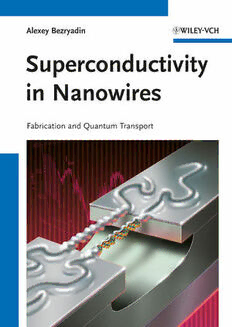
Superconductivity in Nanowires: Fabrication and Quantum Transport PDF
Preview Superconductivity in Nanowires: Fabrication and Quantum Transport
AlexeyBezryadin SuperconductivityinNanowires RelatedTitles Vedmedenko,E. CompetingInteractionsand PatternsinNanoworld 2007 ISBN:978-3-527-40484-1 Wilkening,G.,Koenders,L. Nanoscale CalibrationStandards and Methods DimensionalandRelatedMeasurementsintheMicro-andNanometerRange 2005 ISBN:978-3-527-40502-2 Waser,R.(ed.) Nanoelectronics and InformationTechnology 2012 ISBN:978-3-527-40927-3 Reich,S.,Thomsen,C.,Maultzsch,J. Carbon Nanotubes BasicConceptsandPhysicalProperties 2004 ISBN:978-3-527-40386-8 Alexey Bezryadin Superconductivity in Nanowires Fabrication and Quantum Transport WILEY-VCH Verlag GmbH & Co. KGaA TheAuthor AllbookspublishedbyWiley-VCHarecarefully produced.Nevertheless,authors,editors,and Prof.AlexeyBezryadin publisherdonotwarranttheinformation DepartmentofPhysics containedinthesebooks,includingthisbook,to UniversityofIllinois befreeoferrors.Readersareadvisedtokeepin 1110WestGreenStreet mindthatstatements,data,illustrations, ChampaignIL61801 proceduraldetailsorotheritemsmay USA inadvertentlybeinaccurate. LibraryofCongressCardNo.: appliedfor BritishLibraryCataloguing-in-PublicationData: Acataloguerecordforthisbookisavailable fromtheBritishLibrary. Bibliographicinformationpublishedbythe DeutscheNationalbibliothek TheDeutscheNationalbibliothekliststhis publicationintheDeutscheNationalbibliografie; detailedbibliographicdataareavailableonthe Internetathttp://dnb.d-nb.de. ©2013WILEY-VCHVerlagGmbH&Co.KGaA, Boschstr.12,69469Weinheim,Germany Allrightsreserved(includingthoseoftranslation intootherlanguages).Nopartofthisbookmay bereproducedinanyform–byphotoprinting, microfilm,oranyothermeans–nortransmitted ortranslatedintoamachinelanguagewithout writtenpermissionfromthepublishers. Registerednames,trademarks,etc.usedinthis book,evenwhennotspecificallymarkedas such,arenottobeconsideredunprotectedby law. PrintISBN 978-3-527-40832-0 ePDFISBN 978-3-527-65196-2 ePubISBN 978-3-527-65195-5 mobiISBN 978-3-527-65194-8 oBookISBN 978-3-527-65193-1 Composition le-texpublishingservicesGmbH, Leipzig PrintingandBinding MarkonoPrintMedia PteLtd,Singapore CoverDesign Adam-Design,Weinheim PrintedinSingapore Printedonacid-freepaper V Contents Preface–SuperconductivityandLittle’sPhaseSlipsinNanowires IX Abbreviations–ShortList XI Notations–ShortList XIII ColorPlates XV 1 Introduction 1 2 SelectedTheoreticalTopicsRelevanttoSuperconductingNanowires 15 2.1 FreeorUsableEnergyofSuperconductingCondensates 15 2.2 HelmholtzandGibbsFreeEnergies 18 2.3 FluctuationProbabilities 23 2.4 Work Performed byaCurrent Sourceon theCondensateina Thin Wire 27 2.5 HelmholtzEnergyofSuperconductingWires 29 2.6 GibbsEnergyofSuperconductingWires 31 2.7 RelationshipbetweenGibbsandHelmholtzEnergyDensities 35 2.8 RelationshipbetweenThermalFluctuationsandUsableEnergy 36 2.9 CalculusofVariations 38 2.10 Ginzburg–LandauEquations 39 2.11 Little–ParksEffect 46 2.12 KineticInductanceandtheCPRofaThinWire 50 2.13 DrudeFormulaandtheDensityofStates 51 3 Stewart–McCumberModel 53 3.1 KineticInductanceandtheAmplitudeofSmallOscillations 60 3.2 MechanicalAnalogyfortheStewart–McCumberModel 62 3.2.1 DefiningtheSupercurrentThroughHelmholtzFreeEnergy 65 3.2.2 CubicPotential 66 3.2.3 ThermalEscapefromtheCubicPotential 67 3.3 Macroscopic Quantum Phenomena in the Stewart–McCumber Model 68 3.3.1 MQTinaCubicPotentialatHighBiasCurrents 71 VI Contents 3.4 Schmid–Bulgadaev Quantum Phase Transition in Shunted Junctions 74 3.5 Stewart–McCumberModelwithNormalizedVariables 76 4 FabricationofNanowiresUsingMolecularTemplates 79 4.1 ChoiceofTemplatingMolecules 86 4.2 DNAMoleculesasTemplates 86 4.3 SignificanceoftheSo-Called“WhiteSpots” 88 5 ExperimentalMethods 91 5.1 SampleInstallation 91 5.2 ElectronicTransportMeasurements 95 6 ResistanceofNanowiresMadeofSuperconductingMaterials 101 6.1 BasicProperties 101 6.2 Little’sPhaseSlips 105 6.3 Little’sFit 108 6.4 LAMHModelofPhaseSlippageatLowBiasCurrents 115 6.5 ComparingLAMHandLittle’sFit 122 7 GolubevandZaikinTheoryofThermallyActivatedPhaseSlips 125 8 StochasticPrematureSwitchingandKurkijärviTheory 131 8.1 StochasticSwitchingRevealedbyV–ICharacteristics 131 8.2 “GeigerCounter”forLittle’sPhaseSlips 135 8.3 MeasuringSwitchingCurrentDistributions 139 8.4 Kurkijärvi–Fulton–Dunkleberger(KFD)Transformation 143 8.5 ExamplesofApplyingKFDTransformations 148 8.6 InverseKFDTransformation 152 8.7 Universal3/2PowerLawforPhaseSlipBarrier 153 8.8 RateofThermallyActivatedPhaseSlipsatHighCurrents 157 8.9 KurkijärviDispersionPowerLawsof2/3and1/3 160 9 MacroscopicQuantumTunnelinginThinWires 163 9.1 GiordanoModelofQuantumPhaseSlips(QPS)inThinWires 165 9.2 ExperimentalTestsoftheGiordanoModel 175 9.3 GolubevandZaikinQPSTheory 183 9.4 KhlebnikovTheory 185 9.5 SpheresofInfluenceofQPSandTAPSRegimes 187 9.6 Kurkijärvi–GargModel 189 9.7 Theorem:InverseRelationshipbetweenDispersionandtheSlopeofthe SwitchingRateCurve 195 10 Superconductor–InsulatorTransition(SIT)inThinandShortWires 197 10.1 SimpleModelofSITinThinWires 207 Contents VII 11 Bardeen Formula for the Temperature Dependence of the Critical Current 213 AppendixA SuperconductivityinMoGeAlloys 215 AppendixB VarianceandtheVarianceEstimator 217 AppendixC ProblemsandSolutions 223 References 241 Index 247 IX Preface – Superconductivityand Little’sPhase Slipsin Nanowires Thisbookpresentsanaccountoffabricationtechniques,chargetransportexperi- ments,andtheoreticalmodelsrelatedtosuperconductingnanowires,thatis,thin wiresmadeofsuperconductingmaterialsandhavingdimensionsatthenanome- ter scale.A wireisclassifiedasone-dimensional(1D) ifitsdiameterdissmaller thanthesuperconductingcoherencelength(cid:1).Insuchwires,thesuperconducting condensatewavefunctiononlydependsonthepositionalongthewire,whileitis independentofthepositionwithinthewirecrosssection.Ananowireisclassified p as quasi-one-dimensional(quasi-1D) if d < π 2(cid:1). Such conditionensures that vorticesarenotenergeticallystableinthewire.Therefore,theorderparameteris approximatelyconstantwithinthewirecrosssection.Since(cid:1) divergesatthecriti- caltemperature T,itisnottoohardtomakeawirewhichisquasi-1Dnear T.It c c ismorechallengingtofabricatenanowireswhichare1Dorquasi-1Deveninthe limitofzerotemperature.Recentperfectionofnanotechnologyallowsustomake wireasthinas5nm,whichcanberegardedasquasi-1Devenatzerotemperature. Thisbookprovidesadetailedanalysisofthetransportpropertiesofsuchultrathin wires. Amongotherthings,thesmallsizeofthewirescauses themtobehave as quantumobjects.DuetotheHeisenberg uncertaintyprinciple,suchwiresmight notbetruesuperconductors.Theirstatebecomesuncertainbecausethewiresexist inaquantumsuperpositionofnormalandsuperconductingstates.Astheadmix- tureofthenormalphaseincreases,nominallysuperconductingnanowirescanlose theirabilitytocarrysupercurrentandcanbecomeeithernormalor,whatitmore typical,slightlyinsulating. Evenifquantumfluctuationsarenotsufficientlystrongtodestroysuperconduc- tivity,theohmicresistance Rofathinwireisalwaysgreater thanzero,provided that the temperature, T, is above absolute zero. Due to thermal fluctuations,the phase of the superconducting condensate wavefunction jumps irreversibly, lead- ingtoadecayofthesupercurrent.Suchjumpsarecalledthermallyactivatedphase slips(TAPS)orLittle’sphaseslips(LPS).AdetaileddiscussionofLPSisoneofthe maintopicsofthisbook. Nanowires made of superconducting materials can generally be classified into threedifferentcategories:superconductingorS-typewires,normalorN-typewires, andinsulatingorI-typewires.Assumethat R(T) ! R(0)as T ! 0,whereTis thetemperatureofthenanowireandR(T)isitselectricresistanceasafunctionof X Preface–SuperconductivityandLittle’sPhaseSlipsinNanowires temperature.Also,assume that R denotestheresistanceofthenanowireinthe n normal state, that is, at T > T. Then, R(0) D 0 (at T D 0) defines the S-type c wires,0 < R(0) < R correspondstotheN-type,and R(0) > R characterizes,by n n convention,I-typewires.Thereisnodirectwaytodeterminethetypeofthewire sincetheconditionT D0isimpossibletosatisfyexperimentally.Thus,theclassi- ficationisusuallydoneusingindirectapproaches.Forexample,iftheresistanceis observedtoincreasewithcooling,thenthewireisclassifiedastheI-type.Onthe otherhand,iftheohmicresistancedecreasesexponentiallywithcooling,thenthe wireshouldbeclassifiedastheS-type.TheS-typeclassificationalsorequiresthat thewireexhibitsafinitesupercurrentatsufficientlylowtemperatures.Inthebook, wesummarizethepropertiesofthetwomostcommontypesofnanowires,name- ly,theS-typeandI-typewires,andanalyzethequantumphasetransitionbetween thesetwophases. Thebookisintendedforundergraduateandbeginninggraduatestudentsinter- estedinnanoscalesuperconductivity.Thereadersareassumedtohavesomefamil- iaritywiththebasicsofquantummechanicsandsuperconductivity.Recommend- ed introductorybooks ongeneral aspects of superconductivityare Introduction to Superconductivity by M.Tinkham[1]and Superconductivity of Metals and Alloysby P.G.deGennes[2].Thepresentmonographisfocusedonselectedtopicsrelatedto thinsuperconductingnanowires. Itismypleasuretoacknowledgemyindebtednesstothegraduatestudentsand postdocsIhavesupervisedsince2000.Ofspecialimportanceistheadviceandthe helpful discussions with Liliya Simpson, Anthony T. Bollinger, Ulas C. Coskun, CeliaElliott,DavidS.Hopkins,RobertC.DinsmoreIII,MitrabhanuSahu,Sergei Khlebnikov,ThomasAref,MatthewW.Brenner,PaulGoldbart,AndreyRogachev, Andrey Belkin, Andrey Zaikin, Konstantin Arutyunov,and Victor Vakaryuk. The workwassupportedbytheDOEgrantDE-FG02-07ER46453andbytheNSFgrant DMR10-05645. Campaign,August2012 AlexeyBezryadin XI Abbreviations– Short List BCS Bardeen,Copper,andSchrieffertheoryofsuperconductivity. BCScondensate acoherentquantumstatesofamacroscopicnumberofelec- tronsappearingintheBCStheory. CP Cooperpair. CPR Current–phaserelationship. GL GinzburgandLandauphenomenologicaltheory. GLAG Ginzburg,Landau,Abrikosov,andGor’kovtheory,whichisa microscopictheoryderivedfromBCS,butsimilarinformto theGLtheory. GZ GolubevandZaikintheory(eitherofTAPSorofQPS). I-typewire aninsulatingnanowire,i.e.,ananowiremadeofasupercon- ducting metal, but, due to various reasons, having its zero- temperatureresistancelargerthanitsnormal-stateresistance. JJ Josepshonjunction. KG Kurkijärvi–Gargmodel. LAMH Langer, Ambegaokar, McCumber, and Halperin combined model. LPS Little’sphaseslip. MT moleculartemplating. MQT Macroscopicquantumtunneling. N-typewire Anormalnanowire,thatis,ananowiremadeofasupercon- ducting metal, but, due to various reasons, having its zero- temperature resistance larger than zero but lower or equal compared to its normal-state resistance, which is measured atT > T. c QPS quantum phase slips, usually in quasi-1D superconducting wires.QPSisaparticularcaseofMQT. SB Schmid–Bulgadaevquantumphasetransition. SIS Superconductor–insulator–superconductorjunction. SNS Superconductor–normalmetal–superconductorjunction. SIT Superconductor to insulator quantum phase transition. The meaningofitisthatontheS-sidethewirehaszeroresistance
